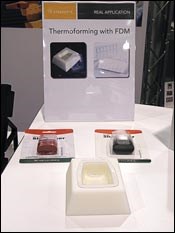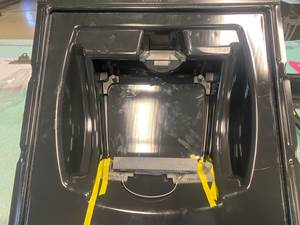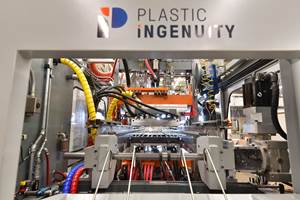Blow Molders and Thermoformers Try Plastic Rapid Tooling
Rapid prototyping (RP) equipment is increasingly being used to manufacture prototype and short-run production molds for blow molded and thermoformed parts.
Rapid prototyping (RP) equipment is increasingly being used to manufacture prototype and short-run production molds for blow molded and thermoformed parts. A range of RP processes including fused-deposition modeling (FDM), 3D printing, and stereolithography (SL) are being employed to lower product-development time and cost. Success has been driven by newer RP materials that are stronger and more heat resistant, and have a finer finish.
RT FINDS A NICHE
Over the last decade, there have been high hopes for a group of technologies known as rapid tooling (RT) as a viable alternative to traditional machining methods. However, these speedy mold-building techniques—many of them based on RP technologies—have gained just a toehold in the general moldmaking arena due to concerns about accuracy, strength, and mold finish.
But recent RP/RT material advances have enabled processors and OEMs to take a second look at RT, particularly for blow molding and thermoforming. RT reportedly has made strong gains in these processes because they are viewed as less taxing on RT materials in terms of impact, pressure, and heat. Thermoforming was one of the first adopters because it is a low-pressure process with heating requirements that can be readily managed.
An innovator in rapid tooling for blow molding and thermoforming is Stratasys Inc. The company’s FDM system starts with a 3D CAD program and builds plastic molds layer by layer from extruded and laminated thermoplastic filament. The system is complemented by a range of “production-grade” thermoplastics including ABS, PC, polyphenylsulfone (PPSF), and blends. They are claimed to offer “robust” properties for tooling needs. For instance, PPSF boasts a glass-transition temperature (Tg) of 229 C/444 F. Recently, Stratasys also introduced Vapor Smoothing technology, which greatly improves surface finish by solvent smoothing the outer layer of material.
In blow molding, there is significant interest in developing molds for prototype PET bottles for water and carbonated soft drinks (CSD), according to Fred Fischer, Stratsys product marketing manager. With FDM tooling, the lead time for prototype parts is reduced from weeks to less than five days, says Fischer. In addition, the cost is reportedly one-third to half that of a prototype aluminum tool. Stratasys usually recommends its PC material for blow molding tools. It can withstand short-run production of hundreds to thousands of HDPE, PET, PVC, PS, or PC parts, according to Fischer.
With the exception of venting and shut-offs, the FDM tool’s design is similar to a machined version. Since the FDM cavity has a small amount of porosity, air trapped between the molded plastic and tool surface is vented through the body of the tool. To minimize flash, a sloped, raised rib is added around the contour of the cavity. Cooling channels can be built into the tool, but Stratasys says it’s simpler and faster to use a standard mounting plate with cooling lines. Since the PC tool retains some heat, more cooling is required.
One container manufacturer used FDM to build a PC mold for 6-in.-tall, 3-in.-diam. HDPE bottles in two days. The customer molded near-production-quality bottles in less than five days from the start of the FDM build. Another manufacturer blow molded 800 PET bottles with no wear, distortion, or dimensional change to the FDM tool. The company concluded that the tool could produce thousands of parts, if necessary.
For thermoform tooling, all of Stratasys’ materials are potential candidates. In demanding applications, PPSF and PC offer a higher Tg than ABS. Depending on the tool and part material, FDM tool life can range from 100 to 1000 parts. With the exception of venting through the porosity of the tool (as in blow molding) and the addition of a perimeter rib, the tool is designed like any typical machined mold. Cooling channels may be constructed in the FDM tool, but it is believed to be simpler and faster to use a standard mounting plate with cooling lines.
One aerospace supplier uses FDM to make thermoform molds for air ducts, engine cowlings, and antenna covers. FDM tooling reportedly costs less and has shorter lead time than composite molds made by hand lay-up of carbon-fiber prepreg.
OTHER RP/RT METHODS
High-performance stereolithography resins like DSM Somos’ NanoTool are also boosting the penetration of rapid tooling into thermoforming and blow molding. The epoxy/acrylate is heavily filled with silica nanoparticles and boasts an HDT of 260 C/500 F. It also reportedly provides superior sidewall quality, along with better detail resolution than other RP materials and processes. Prototype molds for PET bottles can produce from 500 to 1000 bottles, according to Brian Bauman, global technical service and applications development manager.
NanoTool is reportedly gaining traction in thermoformed packaging. Axis Prototypes, an RP service bureau in Montreal, has completed about a dozen rapid-tooling projects using NanoTool. “This opens up a new market for thermoformers in low-volume jobs they couldn’t go after before,” says Robin Clifford, general manager. Molds are produced in about four days and typically produce 20 to 500 parts for food and consumer goods packaging.
A longer cycle time is required to dissipate heat from these molds. And a secondary drilling operation is needed to open vacuum channels.
One of the most economical methods to produce rapid tooling for thermoforming is 3D printing, according to Objet Geometries Inc. Its Eden series of 3D printers is finding broader use by manufacturers who want a one-day mold turnaround and short-run production of up to 500 parts. Objet’s FullCure family of acrylic-based photopolymer materials creates finely detailed molds for thermoformed food and consumer packaging. Recently, Objet worked with a leading toy maker to develop a range of prototype packages for a new line of products.
Related Content
Thermoformer Maximizes Productivity with 3D Printing
Productive Plastics has created an extensive collection of 3D printed manufacturing aids that sharply reduce lead times.
Read MoreThermoformed Container Keeps Battery Cells Safe
Despite last-minute design changes and other unexpected roadblocks, thermoformer TriEnda works with a key supplier on innovative reusable shipping container.
Read MoreIngenuity Is Part of This Former’s Name, and in Its DNA
Plastic Ingenuity started in a garage in 1972 and through a commitment to developing best-in-class products stands today as one of the largest custom thermoformers in the world.
Read MoreUS Merchants Makes its Mark in Injection Molding
In less than a decade in injection molding, US Merchants has acquired hundreds of machines spread across facilities in California, Texas, Virginia and Arizona, with even more growth coming.
Read MoreRead Next
See Recyclers Close the Loop on Trade Show Production Scrap at NPE2024
A collaboration between show organizer PLASTICS, recycler CPR and size reduction experts WEIMA and Conair recovered and recycled all production scrap at NPE2024.
Read MoreBeyond Prototypes: 8 Ways the Plastics Industry Is Using 3D Printing
Plastics processors are finding applications for 3D printing around the plant and across the supply chain. Here are 8 examples to look for at NPE2024.
Read MoreMaking the Circular Economy a Reality
Driven by brand owner demands and new worldwide legislation, the entire supply chain is working toward the shift to circularity, with some evidence the circular economy has already begun.
Read More




%20technique.jpg;width=860)



















